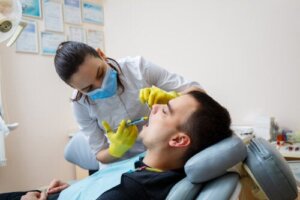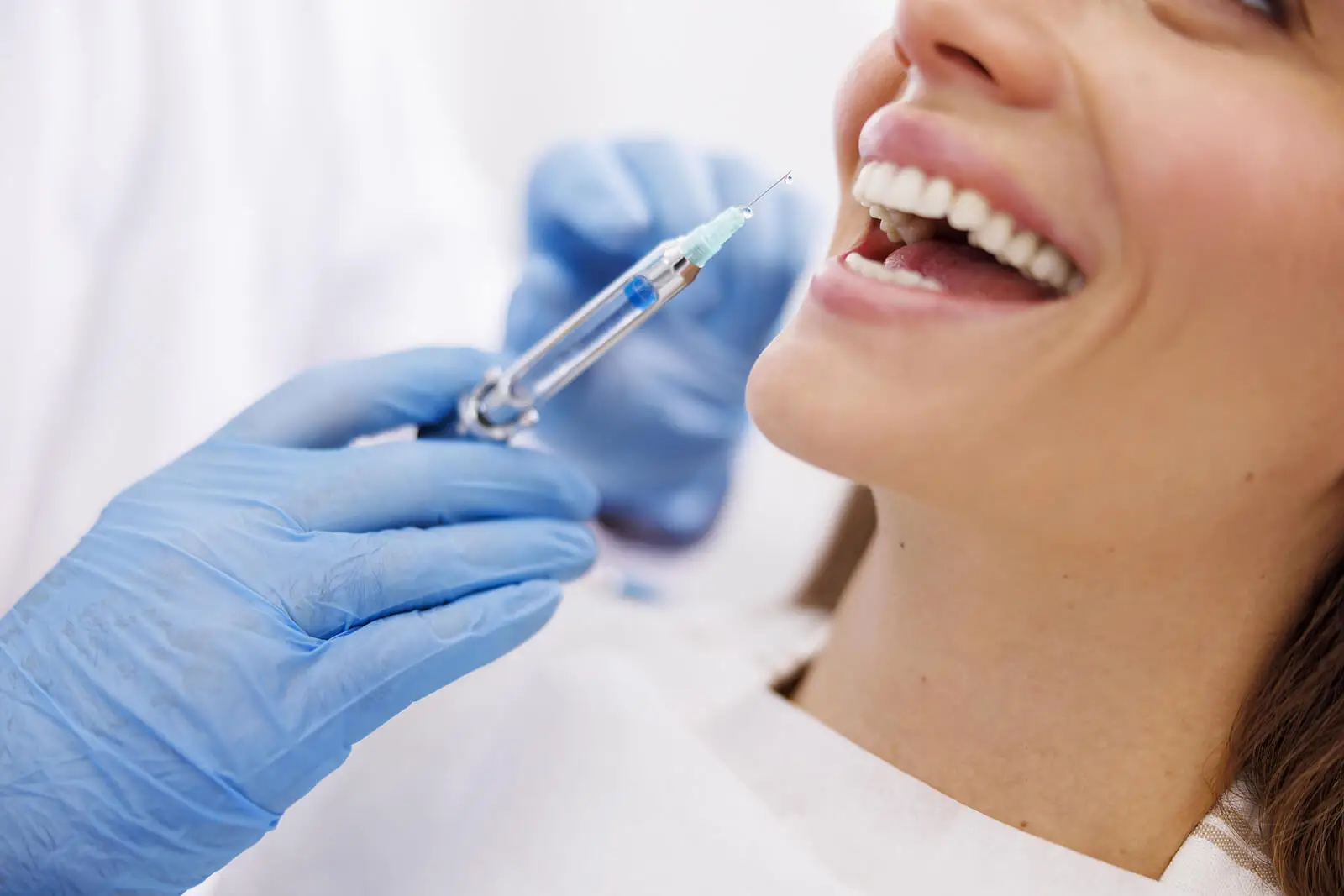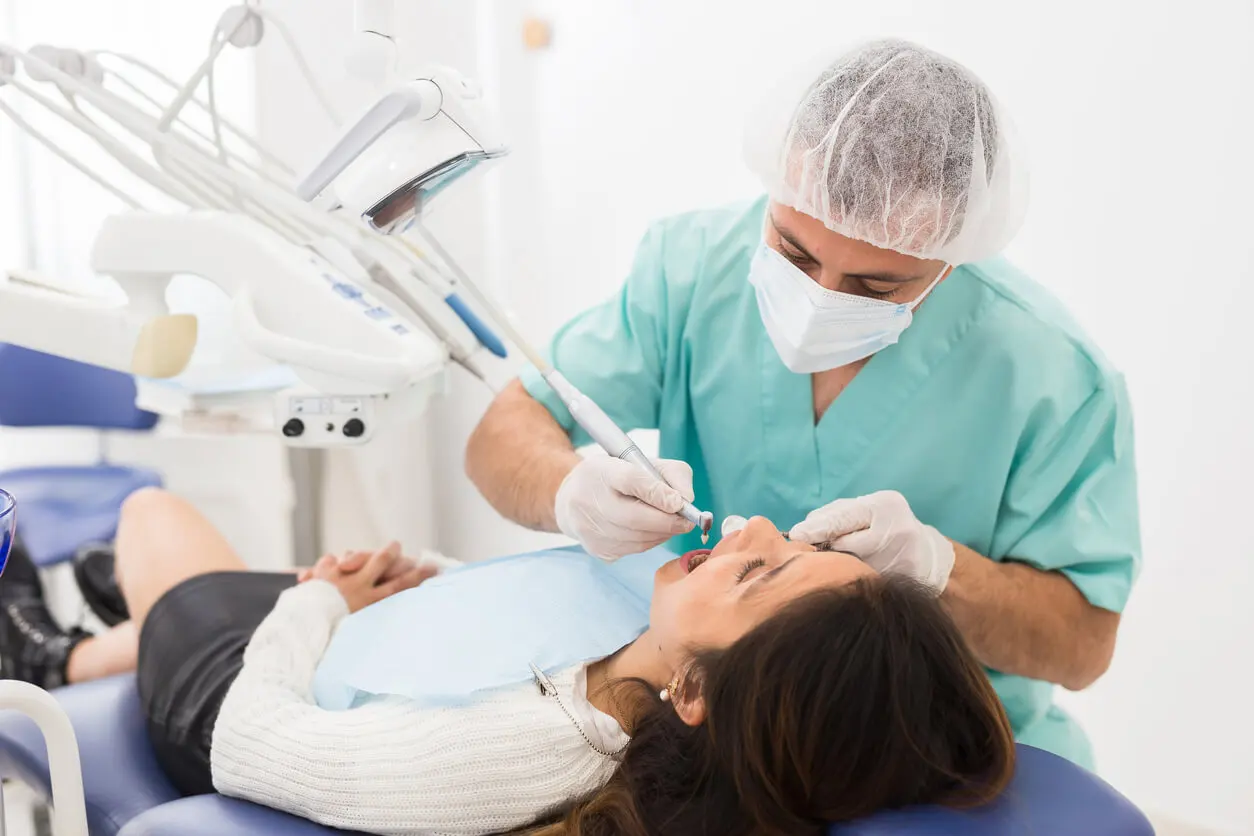Local Anesthesia in Dentistry: Discover its Benefits and Risks


Written and verified by the dentist Vanesa Evangelina Buffa
Local anesthesia used in dentistry allows several common dental procedures to be performed that otherwise would not be possible. This technique eliminates pain and sensitivity in the mouth to prevent discomfort during oral treatments.
It’s often used for complex and uncomfortable procedures to correct an abnormality or help heal an injury. It’s also used for the treatment of complex oral diseases. And although its application involves a needle prick, it allows the person to receive oral treatments without pain.
However, local anesthesia is an intervention that’s not free of adverse side effects. The possibility of unfavorable reactions depends on several factors. However, the dentist will always try to take the necessary precautions to prevent them. Do you want to know more about it? Read on!
What is local anesthesia in dentistry?
Local anesthesia used in dentistry is a procedure performed to inhibit nerve conduction in certain areas of the mouth. It consists of applying a special substance to a site in the oral cavity to eliminate discomfort and sensitivity when performing a treatment.
Although there are different ways to achieve pain suppression in the patient, this method is usually the most commonly used. It’s used in common procedures, such as the following:
- Fillings
- Deep cleanings
- Endodontics
- Tooth extractions
- Implants
The person is conscious and able to communicate when receiving anesthesia and throughout the dental procedure. Only the sensitivity of the area where the dental treatment is performed is eliminated.
There are several substances that can be applied to achieve anesthetic effects. Some of the most common are the following:
- Prilocaine
- Articaine
- Bupivacaine
- Lidocaine
- Mepivacaine
The same can be combined with vasoconstrictors such as epinephrine, which prolong and localize its effect and decrease tissue bleeding.
In general, anesthesia takes about 10 minutes to take effect. The lack of sensitivity lasts between 30 and 60 minutes, depending on the drug used and the patient’s characteristics.
After its application, the person usually feels that the area becomes numb and loses sensitivity. You may also perceive a tingling and the sensation of having a swollen mouth; however, the latter is not the case. The effect disappears a few hours after the intervention.

Types of local anesthesia in dentistry
In dentistry, we can differentiate different types of local anesthesia, depending on the area of the mouth where the medication is injected.
- Infiltrative: The puncture is performed near the roots of the teeth to be desensitized. Once the injection is placed, the liquid diffuses towards the nerve endings. This is frequently used in the upper arch and in some areas of the lower jaw, especially in children.
- Troncular: In this case, the entire sensory nerve that innervates an area of the mouth is blocked. This is frequently used to remove the sensitivity of the lower dental nerve and thus anesthetize the entire lower arch, including teeth, tongue, and lip. In addition, it can be used on the infraorbital, greater palatine, nasopalatine, Antonian, and buccal nerves.
- Intraligamentary: This is applied in the periodontal space, between the dental bone and the dental root. It is usually complemented by one of the two previous ones.
We think you may be interested in reading this, too: LED Teeth Whitening: Advantages, Disadvantages, and Care
The benefits of local anesthesia in dentistry
The main advantage of using local anesthesia in dentistry is the possibility of performing treatments in the mouth without the person feeling discomfort and pain. Otherwise, the interventions could not be performed. In addition, it brings other benefits for both the patient and the dentist.
- The person remains conscious and is able to collaborate during the intervention.
- The patient can leave the office by his or her own means without depending on the assistance of another person.
- It’s easy to place.
- There’s a minimal distortion of the patient’s normal functions.
- The failure rate is very small.
- They are inexpensive and their use does not involve additional expense for the patient.
Like this article? You may also like to read: 9 Natural and Effective Tips for Taking Care of Your Teeth
Risks of local anesthesia
Like any medication applied to the body, local anesthesia used in dentistry isn’t exempt from causing adverse effects. However, these situations are sporadic and infrequent.
According to a study by the Official College of Dentists and Stomatologists of the 1st Region (COEM) on complications associated with oral anesthesia, the following situations can occur:
- Pain during the puncture: As in the case of most injections, the patient may feel the pain of the puncture. This is increased if several punctures are made at the same site, the liquid is injected too quickly, the solution is very cold or the operator isn’t very careful.
- Trismus: This is a spasm of the masticatory muscles that prevents the mouth from opening normally. It may be associated with a pain reflex caused by bleeding, bruising, or trauma to the internal pterygoid muscle during placement of the injection into the jaw.
- Paralysis of the facial nerve: Paralysis can occur immediately when the anesthetic is injected, or later. This occurs when the anesthetic is accidentally placed in the deep lobe of the parotid gland, through which the facial nerve passes.
- Paresthesia: The person perceives numbness, partial loss of sensation, burning, and tingling in the area, even after the anesthesia has worn off.
- Self-induced soft-tissue injuries: With no sensation in the cheek or tongue area, the patient may bite or injure himself without realizing it. At that moment he/she will not feel pain, but when the anesthetic effects wear off, the lesion in the mouth will be bothersome.
- Allergic reactions: Although rare, the medication used for anesthesia may trigger an allergic reaction. It can cause urticaria, pruritus, edema, rhinitis, and, less frequently, an anaphylactic process.
Other complications associated with local anesthesia in dentistry
Some patients may experience other complications associated with anesthesia. Locally, some people experience bruising at the puncture site, ischemia of the facial skin, or develop infections in the anesthetized area.
On a general level, nausea or vomiting may occur. There may also be episodes of headache or headache, sweating, tremors, dizziness, tiredness, and dry mouth. In very rare cases there is the possibility of experiencing convulsions, heart problems, respiratory failure, and coma.

Special precautions before using local anesthetics
There are conditions and situations that require a special evaluation by the dentist before proceeding to use an anesthetic in the mouth. To prevent any problems, it’s essential that there is adequate communication between the dentist and the patient.
On the one hand, the dentist should inform the person about the risks and the safety measures that are taken to avoid them. On the other hand, the patient should share all of their health data, diseases, medications, and the information he/she considers useful before the procedure with their healthcare professional.
These are some situations that the patient should inform their dentist about when visiting:
- Pregnancy: Pregnant women should inform the dentist about their condition (even if it’s a suspicion). Although local anesthesia is safe during pregnancy, it’s preferable to use it in the second trimester.
- Special needs: Some patients with special needs may have medical complications that require a general evaluation beforehand. In addition, they often require adjustment of the dose of anesthetics. It may be advisable to combine the procedure with some form of sedation to facilitate the performance of the puncture maneuvers.
- Age: Children and older adults may also require special considerations when using local anesthesia.
- Liver, kidney, lung, or heart problems: People with these conditions may need to have their doses adjusted or use products without vasoconstrictors.
- Oral infections or open sores in the mouth: The lesions should be allowed to heal before the injection is performed.
Communication between the dentist and patient is key
As you have seen, local anesthesia in dentistry brings many benefits when it comes to many dental treatments. However, it can produce some adverse reactions, even though this is not very common.
One of the ways to avoid setbacks is to establish a dialogue between the dentist and the patient. Clearing up any doubts and informing yourself about possible situations associated with the state of your health is the key to using this resource successfully.
All cited sources were thoroughly reviewed by our team to ensure their quality, reliability, currency, and validity. The bibliography of this article was considered reliable and of academic or scientific accuracy.
- Campos Medina, A. S. (2022). Evidencia científica sobre el uso de anestésicos locales en Odontología.
- Gierl, F. (2011). La anestesia local en odontología. Quintessence: Publicación internacional de odontología, 24(7), 384-389.
- Martínez, A. M., Escorcia, V. S., & Caballero, A. J. D. (2021). Complicaciones asociadas a la anestesia bucal: diagnóstico y manejo. Científica dental: Revista científica de formación continuada, 18(2), 39-44.
- Collado-Chagoya, R., Cruz-Pantoja, R. A., Hernández-Romero, J., León-Oviedo, C., Velasco-Medina, A. A., Velázquez-Sámano, G., & Chávez-Ortega, S. G. (2019). Alergia a anestésicos locales: serie de casos y revisión literatura. Revista mexicana de anestesiología, 42(4), 296-301.
- García Peñín, A., Guisado Moya, B., & Montalvo Moreno, J. J. (2003). Riesgos y complicaciones de anestesia local en la consulta dental: Estado actual. RCOE, 8(1), 41-63.
- Flores Cassagne, X. A. (2021). Riesgo y complicaciones de la anestesia local en odontología (Bachelor’s thesis, Universidad de Guayaquil. Facultad Piloto de Odontología).
- Ho, J. P. T., van Riet, T. C., Afrian, Y., Sem, K. T. C. J., Spijker, R., de Lange, J., & Lindeboom, J. A. (2021). Adverse effects following dental local anesthesia: a literature review. Journal of Dental Anesthesia and Pain Medicine, 21(6), 507.
- Yalcin, B. K. (2019). Complications associated with local anesthesia in oral and maxillofacial surgery. Topics in Local Anesthetics, 151.
This text is provided for informational purposes only and does not replace consultation with a professional. If in doubt, consult your specialist.








